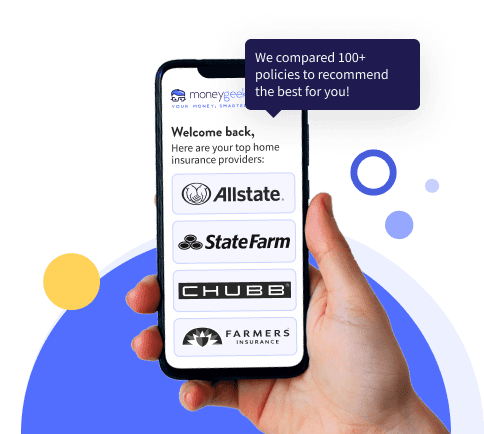Hazard insurance, often called dwelling coverage or Coverage A, is the part of your homeowners insurance policy that covers the cost to repair or rebuild your home’s physical structure after certain disasters. This includes the walls, roof and foundation of the house. It’s not a separate policy you can purchase on its own; instead, it’s automatically included in standard homeowners insurance policies.
Hazard Insurance
Hazard insurance, also known as dwelling coverage or coverage A, is a standard part of home insurance policies that pays to repair or rebuild your home’s structure after a covered peril. It is not a separate policy from home insurance.
Find out if you're overpaying for home insurance below.

Updated: October 29, 2025
Advertising & Editorial Disclosure
Hazard insurance, also known as dwelling coverage or coverage A, pays to repair or rebuild your home after covered perils like a fire, lightning, theft or vandalism.
Hazard insurance is a part of homeowners insurance policies and cannot be bought alone.
Hazard insurance costs $292 per month on average, with USAA as MoneyGeek’s top overall pick. However, because USAA is only available to military members, AIG Insurance is the best option for most homeowners.
Ensure you're getting the best rate for your home insurance. Compare quotes from the top insurance companies.
What is Hazard Insurance for Homeowners?
Hazard insurance is not a separate policy but a part of homeowners insurance that covers your home’s structure, often called dwelling coverage. On the other hand, a standard homeowners policy also includes financial protection beyond hazards, such as personal property, liability and loss of use coverage. In short, hazard insurance is one piece of the broader protection you get with homeowners insurance.
What Does Hazard Insurance Cover?
Home insurance policies generally fall under two types of coverage: named perils and open perils. Named perils protect your home only against specific risks listed in your policy, while open perils cover everything except the exclusions spelled out in your contract.
In both cases, hazard coverage applies to sudden, accidental events that can damage or destroy your home’s structure. Here are the common perils that homeowners insurance typically covers:
Coverage includes events such as fire, lightning, windstorms, hail and even volcanic eruptions. These natural perils can cause major structural damage, making them core protections under hazard insurance.
Sudden events like burst pipes, electrical surges or the weight of snow and ice on your roof are often covered. Because these are unpredictable, insurers recognize them as insurable risks.
Theft, vandalism, riots and damage caused by vehicles or aircraft are also part of standard coverage. These protections extend beyond natural events, guarding your home against man-made hazards.
What Doesn’t Hazard Insurance Cover?
Even though hazard insurance offers broad protection, there are specific exclusions that require separate policies or maintenance on your part. Understanding these gaps helps you avoid costly surprises when filing a claim.
Floods and earthquakes are among the most common exclusions, so homeowners in high-risk areas often need separate policies for these risks.
Issues like mold, rot, infestations or gradual deterioration are not covered. These are considered preventable through proper upkeep, so they fall on the homeowner’s responsibility.
Losses caused by war, nuclear hazards, government action or intentional damage are not insurable under a hazard policy. These exclusions reflect risks outside the scope of standard homeowners coverage.
Imagine you have $200,000 in hazard insurance. If a fire causes $180,000 in damage and your deductible is $2,000, your insurer would pay $178,000. This ensures your home can be restored without leaving you responsible for the full financial burden.
Average Cost of Hazard Insurance
The cost of a hazard insurance policy varies per person. On average, it can be between $154 and $899 per month, depending on the insurance provider.
| $100K Dwelling / $50K Personal Property / $100K Liability | $154 | $1,848 |
| $250K Dwelling / $125K Personal Property / $200K Liability | $292 | $3,503 |
| $500K Dwelling / $250K Personal Property / $300K Liability | $495 | $5,939 |
| $750K Dwelling / $375K Personal Property / $500K Liability | $700 | $8,401 |
| $1MM Dwelling / $500K Personal Property / $1MM Liability | $899 | $10,792 |
**NOTE: The rates above are averages based on a sample homeowner profile. Actual rates may differ. Talk with several insurers and compare home insurance quotes based on your specific home and personal factors.
Factors Affecting the Cost of Hazard Insurance
The price of hazard insurance isn’t the same for every homeowner. Insurers consider several factors about your home and your personal profile when calculating rates.
- Age of the Home: Older homes may cost more to insure because they often need updates or repairs that increase risk.
- Construction Materials: Homes built with brick or stucco may be cheaper to cover than those with wood, which is more vulnerable to fire.
- Roof Type and Condition: A durable roof made of metal or slate can lower your premiums compared to one with older shingles.
- Square Footage: Larger homes usually cost more to rebuild, leading to higher insurance costs.
- Safety Features: Security systems, smoke detectors and fire extinguishers can reduce premiums by lowering the chance of severe damage.
- Location: Homes in areas prone to wildfires, hurricanes or high crime may have higher premiums due to increased risk.
- Credit History: A strong credit record can help you secure better rates since insurers view it as a sign of financial reliability.
- Claims History: Frequent past claims can raise your costs, as insurers may see you as more likely to file again.
- Coverage Gaps: If you’ve gone without insurance before, insurers may charge more due to the perceived higher risk.
Best Hazard Insurance Companies
Many insurance companies offer hazard insurance as part of their homeowners insurance policies. USAA is MoneyGeek's top pick for hazard insurance, with AIG Insurance as the runner-up. Take a look at the best home insurance companies below with their average costs.
| USAA | $178 | $2,134 | 97 |
| AIG Insurance | $91 | $1,093 | 95 |
| Amica | $117 | $1,400 | 95 |
| CSAA | $124 | $1,486 | 91 |
| AAA | $143 | $1,721 | 91 |
| Farmers | $185 | $2,225 | 88 |
| Chubb | $385 | $4,615 | 88 |
| Allstate | $198 | $2,377 | 86 |
| Homesite | $214 | $2,570 | 84 |
| Nationwide | $279 | $3,346 | 84 |
| American Modern | $175 | $2,097 | 80 |
| Progressive | $454 | $5,447 | 76 |
| Travelers | $558 | $6,691 | 73 |
**NOTE: The rates above are based on a policy with $250,000 in dwelling coverage, $125,000 in personal property coverage and $200,000 in liability. Although USAA has the highest MoneyGeek score, it's only available to active military, veterans and their families.

MoneyGeek Top Pick
USAA
Specifically for active and retired military members and their families, USAA ranks highly for customer satisfaction and affordability. Homeowners insurance is one of the many insurance products it offers, alongside auto, life, umbrella insurance and more.

MoneyGeek Top Pick
AIG
For the majority of homeowners, AIG insurance is the best hazard insurance provider with a MoneyGeek score of 95 out of 100. Aside from ranking highly in affordability, customer experience and coverage options, AIG Insurance policyholders can also purchase auto insurance or travel insurance, among other financial services.
How to Buy Hazard Insurance
You can’t purchase hazard insurance on its own; it’s built into a standard homeowners insurance policy. To get coverage, you’ll need to shop for homeowners insurance and make sure the dwelling coverage portion meets your needs.
- 1Assess Your Coverage Needs
Start by estimating how much it would cost to rebuild your home if it were a total loss. This figure will help guide the level of dwelling coverage you should look for.
- 2Gather Home and Personal Information
Insurers will ask about your home’s age, size, construction type and safety features. They’ll also review your credit history and claims record to help determine your rates.
- 3Shop Around and Compare Quotes
Compare home insurance quotes from at least three different insurers to see how coverage and pricing differ. This will help you find affordable home insurance that suits your needs.
- 4Review Company Reputation
Beyond price, consider financial strength ratings and customer satisfaction scores. Strong ratings give you confidence that the company can pay claims reliably.
- 5Select a Policy and Provide Proof
Once you choose a policy, your insurer will issue documents showing your hazard insurance coverage. Your mortgage lender will require this proof before finalizing your loan.
How Much Hazard Insurance Do You Need?
The amount of hazard insurance you need depends on your home’s unique characteristics and potential risks. Factors like local building costs, the type of materials used in construction and your home’s overall size and features all play a role in determining the right level of coverage. A licensed agent can help calculate an amount that ensures your home is fully protected.
Your mortgage lender will also set minimum hazard coverage requirements to safeguard their investment. Lenders often require enough coverage to rebuild the home in case of a total loss. This means your hazard insurance amount isn’t just about your preferences — it must also meet the standards set by your loan provider.
Hazard Insurance for Homeowners: Bottom Line
Hazard insurance, also known as dwelling coverage, is the part of homeowners insurance that protects your home’s structure against risks like fire, wind or vandalism. It doesn’t cover every event, with common exclusions including floods, earthquakes and normal wear and tear.
The cost depends on factors such as your home’s age, size, construction materials, location and your insurance history. Because most lenders require enough coverage to rebuild your home after a total loss, hazard insurance is an essential part of securing and maintaining a mortgage.
Ensure you're getting the best rate for your home insurance. Compare quotes from the top insurance companies.
Hazard Insurance for Home: FAQ
Understanding the difference between hazard insurance and homeowners insurance can be confusing at first, but these frequently asked questions can help clear up the confusion.
Is hazard insurance the same as homeowners insurance?
Hazard insurance is part of homeowners insurance. Hazard insurance covers the actual structure of your home. Homeowners insurance policies, which include hazard insurance, provide comprehensive coverage for your home. You cannot purchase hazard coverage as a standalone policy.
Is hazard insurance required if I own a home?
While no laws require you to purchase hazard insurance, if your home is financed, your mortgage lender most likely will require you to buy it to protect their investment.
Is hazard insurance tax-deductible?
Homeowners insurance, which includes hazard insurance, is considered a personal expense and is not tax-deductible.
What is hazard insurance on a home loan?
As part of a homeowners insurance policy, hazard insurance is coverage that pays for repairs to (or the reconstruction of) your home due to damage or loss.
Do I need hazard insurance if I need homeowners insurance?
You need both hazard insurance and homeowners insurance because hazard insurance is a component of homeowners insurance. Hazard insurance, otherwise known as dwelling coverage, is included by default in standard homeowners insurance policies
Best Hazard Insurance: Our Ratings Methodology
To rank the top home insurance companies for hazard insurance, MoneyGeek calculated a unique score for each company using premium data for companies offering service in more than 35 states on average. This data includes J.D. Power for customer service, AM Best for financial stability and Quadrant Information Services for affordability.
MoneyGeek sourced pricing information from Quadrant Information Services to calculate the average cost of hazard insurance on both a state and national level. Using a homeowners insurance policy with $250,000 in dwelling coverage and $125,000 of personal property, the scores are on a scale of 0 to 100 on the national level.
Home Hazard Insurance: Related Pages
About Mark Fitzpatrick

Mark Fitzpatrick, a Licensed Property and Casualty Insurance Producer, is MoneyGeek's resident Personal Finance Expert. With over five years of experience analyzing the insurance market, he conducts original research and creates tailored content for all types of buyers. His insights have been featured in publications like CNBC, NBC News and Mashable.
Fitzpatrick holds a master’s degree in economics and international relations from Johns Hopkins University and a bachelor’s degree from Boston College. He's also a five-time Jeopardy champion!
He writes about economics and insurance, breaking down complex topics so people know what they're buying.
sources
- Insurance Information Institute. "Homeowners Insurance Basics." Accessed April 18, 2024.






